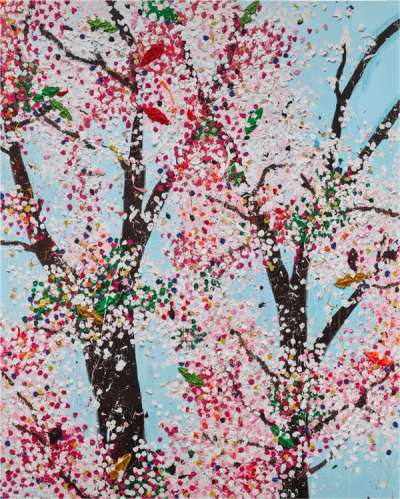Flexing in the Art World
 Dollar Sign 9 (F. & S. II.285) © Andy Warhol 1982
Dollar Sign 9 (F. & S. II.285) © Andy Warhol 1982MyPortfolio
Art has always been associated with status, and for centuries, owning masterpieces has been a symbol of wealth and power. From Renaissance paintings to contemporary installations, art has been a marker of social status, intellectual sophistication, and cultural capital. However, in recent years, the art market has taken a turn towards the extravagant, with collectors seeking out “status symbol masterpieces” that serve as trophies and public declarations of their affluence.
Delving into the cultural phenomenon of “art flexing” and its history, we also examine the current landscape of the art market and explore the specific attributes that make certain artworks desirable as status symbols. By exploring the intersection of art, money, and social hierarchy, we shed light on the complex dynamics at play in the world of contemporary art collecting.
 Image © Flickr (CC) / Untitled (Skull) © Jean-Michel Basquiat 1982
Image © Flickr (CC) / Untitled (Skull) © Jean-Michel Basquiat 1982The Power Of Art As A Status Symbol
Demonstrating wealth, power, and prestige, art has long been a powerful symbol of status. From monarchs adorning their palaces with masterpieces, to aristocrats commissioning portraits and sculptures, art has historically been used as a showcase of wealth. Its association as a status symbol continues to be upheld today with wealthy individuals, celebrities and corporations using it to enhance their brand image and prestige.
Celebrities like Jay-Z and Beyoncé have amassed impressive art collections, showcasing their cultural capital and sophistication. Similarly, corporations like Goldman Sachs and Deutsche Bank use art to showcase their wealth and status to clients and employees.
However, the role of art as a status symbol has been impacted by mass production and consumerism. The rise of reproductions and replicas has decreased the exclusivity of owning original art, leading some to argue that art's value as a status symbol has diminished.
As Jerry Saltz states, “we have allowed ourselves to be fooled into thinking that the most exclusive things are the most valuable, and the most expensive things are the most exclusive.” Despite this, owning a masterpiece remains a sign of social status and cultural capital, and the desire to own and display art as a status symbol remains strong.
 Image © Wikipedia (CC) / Arnolfini Portrait © Jan van Eyck 1434
Image © Wikipedia (CC) / Arnolfini Portrait © Jan van Eyck 1434Uncovering Hidden Details in Masterpieces
Masterpieces are valued not just for their aesthetic appeal, but also for their cultural and historical significance. However, there is often more to these artworks than meets the eye, with hidden details revealing deeper layers of meaning and adding complexity to a piece.
Taking Leonardo da Vinci's infamous Mona Lisa as an example. Her enigmatic smile is one of the most recognisable images in the world, but upon closer inspection, one can see tiny details like her eyelashes and the landscape in the background, which contribute to the painting's sense of depth and realism.
Another example is Jan van Eyck's Arnolfini Portrait, which includes a convex mirror in the background that reflects the couple and two other figures. The reflection reveals a hidden perspective, allowing the viewer to see the entire room and adding a sense of realism to the painting.
Technological advancements and scientific research have also played a significant role in uncovering hidden details. X-ray imaging and infrared reflectography have been used to reveal underdrawings and hidden layers in works by artists such as Rembrandt and Vermeer.
Uncovering hidden details in masterpieces allows us to better understand the specific and particular intentions of the artist and the cultural and historical context in which the artwork was created. The use of technology and scientific research allows us to uncover these hidden details and enhances our appreciation of art.
Ancient Masterpieces and Contemporary Art Forms
From ancient Greek sculptures to contemporary street art, owning a masterpiece has always been a sign of social standing. However, the way we perceive and create art has evolved significantly over time. Ancient masterpieces were created for different purposes, such as to tell a story or celebrate gods and heroes, while contemporary art forms are more focused on exploring new ideas and pushing boundaries.
One of the most significant trends in the art world is the rise of digital art. The use of technology has opened up new possibilities for artists to create immersive experiences and interactive installations, and NFTs are further revolutionising art. Street art has also gained mainstream recognition in recent years, with artists like Banksy and Shepard Fairey becoming household names. Performance art has also seen a resurgence, with artists like Marina Abramović and Tino Sehgal blurring the lines between art and everyday life.
Despite differences in style and purpose, both ancient masterpieces and contemporary art forms share a common goal: to move the viewer. As David Hockney once said, “Art has to move you and design does not, unless it's a good design for a bus.” Whether it's a 2,000-year-old sculpture or a Banksy mural, the ability to evoke an emotional response is what makes art valuable.
The impact of globalisation and cultural diversity has also played a significant role in shaping the evolution of art. As artists from different parts of the world share their perspectives and influences, we are seeing a more diverse range of styles and themes. For example, the works of contemporary artists like Ai Weiwei and Yayoi Kusama reflect their cultural heritage and the political issues they are passionate about.
While the art world has undergone significant changes over time, the value of a masterpiece as a status symbol remains. As we continue to explore new ideas and push boundaries in art, we can be certain that the role of art as a status symbol will continue to evolve.
The Art of Moving Masterpieces
While often viewed as a purely aesthetic object and appreciated for its beauty and craftsmanship, art has a much deeper meaning and significance beyond its surface appearance. It can serve as a reflection and commentary on social, political, and cultural issues, as well as a tool for activism and protest, self-expression and communication.
For instance, Banksy's politically charged street art speaks volumes about the contemporary socio-political landscape. His works, such as Girl With Balloon and Love Is In The Air question authority, challenge the status quo, and inspire social change. Similarly, Kara Walker's silhouettes address the history of racism and slavery in not just America but the entire western landscape, while Ai Weiwei's installations draw attention to issues of human rights and government censorship in China.
Furthermore, the interpretation and creation of meaning in art lie not only in the hands of the artist but also in the viewer. Each individual brings their own experiences, biases, and cultural backgrounds to their interpretation of a work of art. The viewer's interpretation can be influenced by their knowledge of the artist, the historical and cultural context, and the artwork's intended message. To add to that, the role of the art world, including curators, art critics, and collectors, is also essential in shaping the meaning and significance of art. Their choices in which works to display, how to display them, and the accompanying context can significantly impact how a piece is interpreted and understood.
Chuck Close put it succinctly when he said that the viewer completes the work of art. If one may be bold to add, it is not just the viewer but every single stakeholder through whose mind the work of art journeys once it sets out from the mind of the artist to finally reach you.
 Image © Wikipedia (CC) / Las Meninas © Diego Velázquez 1656
Image © Wikipedia (CC) / Las Meninas © Diego Velázquez 1656Art as a Mirror of Society: Examining the Social and Cultural Context of Masterpieces
Art has always been a mirror of society, reflecting its values, beliefs, and cultural norms. Examining the social and cultural context of masterpieces is crucial in understanding their meaning and significance. For example, Diego Velázquez's painting Las Meninas is a complex representation of the Spanish court and the status of art in the 17th century. The painting captures the power dynamics between the royals and their attendants, as well as the relationship between the artist and his patrons.
Similarly, Pablo Picasso's Guernica is a powerful anti-war statement that reflects the atrocities committed during the Spanish Civil War. The painting captures the horror and despair of the bombing of the town of Guernica and the impact of war on innocent civilians.
Artists have played a significant role in shaping and challenging the dominant narratives of their time. For instance, Frida Kahlo's self-portraits challenged traditional gender roles and celebrated her Mexican heritage. She used her art to explore her personal struggles and political beliefs, creating powerful works that resonate with audiences to this day.
 Image © Wikipedia (CC) / Wind of Shenzhen: Data Paintings © Refik Anadol 2019
Image © Wikipedia (CC) / Wind of Shenzhen: Data Paintings © Refik Anadol 2019The Intersection of Art and Technology: New Frontiers in Contemporary Art
Just like the intersection of art and finance, art and technology have always converged, but the digital age has opened up new frontiers for artists to experiment with. The proliferation of digital devices and social media platforms has created new opportunities for artists to create, share, and monetise their works. For example, digital artists such as Refik Anadol use artificial intelligence to create mesmerising visuals that explore the relationship between technology and human perception. Similarly, John Gerrard uses digital simulations to create immersive installations that address global issues such as climate change.
However, the use of technology in art also raises ethical and social concerns. For instance, the issue of copyright infringement has become more complex in the digital age, where artworks can be easily copied and shared online. Moreover, the use of surveillance technologies in art, such as facial recognition, has sparked debates about privacy and the role of art in society.
Despite these concerns, technology has undoubtedly expanded the possibilities of contemporary art and enabled artists to engage with audiences in new ways. As technology continues to evolve, it will be exciting to see how artists will continue to push the boundaries of what is possible in the intersection of art and technology.
As we reflect on the significance and relevance of art as a status symbol, it is important to consider the role of art in shaping our values, beliefs, and culture. Art has the power to challenge our perspectives, provoke thought, and inspire change. It is not just a commodity to be bought and sold, but a medium of expression and communication.
While engaging with art, we must question our own biases and assumptions, and seek to broaden our perspectives. How can we use art to create a more equitable and just society? How can we support artists from diverse backgrounds and amplify their voices? These are the questions that we must grapple with as we navigate the complex world of art and status.

























